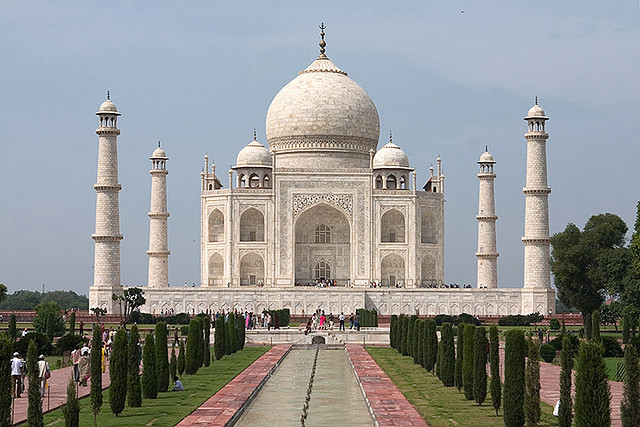Taj Mahal

Taj
Mahal. Agra, Uttar Pradesh, India. Masons, marble workers, mosaicists,
and decorators working under the supervision of Ustad Ahmad Lahori,
architect of the emperor. 1632–1653 C.E. Stone masonry and marble with
inlay of precious and semiprecious stones; gardens.
- During his third regnal year, his favorite wife, known as Mumtaz Mahal, died due to complications arising from the birth of their fourteenth child. Deeply saddened, the emperor started planning the construction of a suitable, permanent resting place for his beloved wife almost immediately. The result of his efforts and resources was the creation of what was called the Luminous Tomb in contemporary Mughal texts and is what the world knows today as the Taj Mahal.
- Sunni Muslims favor a simple burial, under an open sky. But notable domed mausolea for Mughals; were built prior to Shah Jahan’s rule
- The Taj is, however, exceptional for its monumental scale, stunning gardens, lavish ornamentation, and its overt use of white marble.
- First conquered by Muslim invaders in the eleventh century, the city had been transformed into a flourishing area of trade during Shah Jahan’s rule.
- meticulously planned gardens, lush with flowering bushes and fruit-bearing trees in the sixteenth century.
- Qur’anic verses inscribed into the walls of the building and designs inlaid with semi-precious stones—coral, onyx, carnelian, amethyst, and lapis lazuli—add to the splendor of the Taj’s white exterior.
- The dominant theme of the carved imagery is floral, showing some recognizable, and other fanciful species of flowers—another link to the theme of paradise
- Some of the Taj Mahal’s architecture fuses aspects from other Islamic traditions, but other aspects reflect with indigenous style elements.
- From the outset, the Taj was conceived of as a building that would be remembered for its magnificence for ages to come, and to that end, the best material and skills were employed.
- Abdul Haqq was chosen as the calligrapher, and Ustad Ahmad Lahauri was made the supervisor. Shah Jahan made sure that the principles of Mughal architecture were incorporated into the design throughout the building process.
- another theory maintains that the Taj Mahal is a symbolic representation of a Divine Throne—the seat of God—on the Day of Judgment.
- the Taj was something of a vanity project, built to glorify Mughal rule and the emperor himself.
- is believed to be the most recognizable sight in the world today.
- the world’s most extravagant and memorable mausoleum.